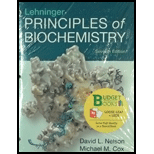
Concept explainers
(a)
To describe: The effect of increasing the distance between the leader peptide gene and sequence 2 on transcription of the E.coli trp operon.
Introduction:
Transcription attenuation is a mechanism which regulates the translation of a leader peptide by controlling the transcription of structural gene. Trp operon contains two trp codons at attenuator region that forms stem-loop structure. Sequence 1 encodes the leader peptide and sequence 2 is responsible for the constitutive expression.
(b)
To describe: The effect of increasing the distance between sequence 2 and sequence3 on transcription of the E.coli trp operon.
Introduction:
In the presence of tryptophan, occurrence of translation of leader sequences result in blocking the sequence 2. Blocking of sequence 2 followed by transcription of sequence 3 and sequence 4, and formation of attenuator structure.
(c)
To describe: The affect of removing sequence 4 on transcription of the E.colitrp operon.
Introduction:
In the presence of tryptophan, occurrence of translation of leader sequences result in blocking the sequence 2. Blocking of sequence 2 followed by transcription of sequence 3 and sequence 4, and formation of attenuator structure.
(d)
To describe: The effect of changing the two tryptophan (Trp) codons in the leader peptide gene to histidine (His) codons, on transcription of the E.coli trp operon.
Introduction:
Repressible operon represses the expression of structural gene. For example trp-operon have structural gene E, D, C, B and A that are repressed or inactive in the present of tryptophan. As the trp codon forms attenuation structure and make the operon sensitive against the tryptophan.
(e)
To describe: The effect of eliminating the ribosome-binding site for the gene that encodes the leader peptide on transcription of the E.coli trp operon.
Introduction:
Transcription attenuation is a mechanism which regulates the translation of a leader peptide by controlling the transcription of structural gene. Trp operon contains two trp codons at attenuator region that forms stem-loop structure. Sequence 1 encodes the leader peptide and sequence 2 is responsible for the constitutive expression
(f)
To describe: The effect of changing several nucleotides in sequence 3 so that it can base pair with sequence 4 but not with sequence 2, on transcription of the E.coli trp operon.
Introduction:
Transcription attenuation is a mechanism which regulates the translation of a leader peptide by controlling the transcription of structural gene. Trp operon contains two trp codons at attenuator region that forms stem-loop structure. Sequence 1 encodes the leader peptide and sequence 2 is responsible for the constitutive expression and sequence 3 and sequence 4 is responsible for the formation of attenuation structure.
Trending nowThis is a popular solution!

Chapter 28 Solutions
Loose-leaf Version for Lehninger Principles of Biochemistry 7E & SaplingPlus for Lehninger Principles of Biochemistry 7E (Six-Month Access)
- Biochemistry Please help. Thank you When carbamyl phosphate is joined to L-ornathine, where does the energy for the reaction come from?arrow_forwardBiochemistry Question Please help. Thank you What is the function of glutamate dehydrogenase?arrow_forwardBiochemistry Question Please help. Thank you How and why does a high protein diet affect the enzymes of the urea cycle?arrow_forward
- Biochemistry What is the importance of the glucose-alanine cycle?arrow_forwardBiochemistry Assuming 2.5 molecules of ATP per oxidation of NADH/(H+) and 1.5molecules of ATP per oxidation of FADH2, how many ATP are produced per molecule of pyruvate? Please help. Thank youarrow_forward1. How would you explain the term ‘good food’? 2. How would you define Nutrition? 3. Nutrients are generally categorised into two forms. Discuss.arrow_forward
- Biochemistry Question. Please help solve. Thank you! Based upon knowledge of oxidation of bioorganic compounds and howmuch energy is released during their oxidation, rank the following, from most to least, with respect to how much energy would be produced from each during their oxidation. Explain your placement for each one.arrow_forwardBiochemistry Question.For the metabolism of amino acids what is the first step for theirbreakdown? Why is it necessary for this breakdown product to be transported to the liver? For the catabolism of the carbon backbone of these amino acids, there are 7 entry points into the “standard” metabolic pathways. List these 7 entry points and which amino acids are metabolized to these entry points. Please help. Thank you!arrow_forwardBiochemistry Question. Please help. Thank you. You are studying pyruvate utilization in mammals for ATP production under aerobic conditions and have synthesized pyruvate with Carbon #1 labelled with radioactive C14. After only one complete cycle of the TCA cycle, which of the TCA cycle intermediates would be labeled with C14? Explain your answer. Interestingly, you find C14 being excreted in the urine. How does it get there?arrow_forward
- Biochemistry question. Please help with. Thanks in advance For each of the enzymes listed below, explain what the enzyme does including function, names (or structures) of the substrate and products and the pathway(s) (if applicable) it is/are found in. (a) ATP synthetase (b) succinate dehydrogenase (c) isocitrate lyase (d) acetyl CoA carboxylase (e) isocitrate dehydrogenase (f) malate dehydrogenasearrow_forwardDraw and name each alcohol and classify it as primary, secondary, or tertiary. Explain your answer thoroughly.arrow_forwardDraw the product of each reaction. If there are multiple products, draw only the major product. Explain your answer thoroughly.arrow_forward
 BiochemistryBiochemistryISBN:9781319114671Author:Lubert Stryer, Jeremy M. Berg, John L. Tymoczko, Gregory J. Gatto Jr.Publisher:W. H. Freeman
BiochemistryBiochemistryISBN:9781319114671Author:Lubert Stryer, Jeremy M. Berg, John L. Tymoczko, Gregory J. Gatto Jr.Publisher:W. H. Freeman Lehninger Principles of BiochemistryBiochemistryISBN:9781464126116Author:David L. Nelson, Michael M. CoxPublisher:W. H. Freeman
Lehninger Principles of BiochemistryBiochemistryISBN:9781464126116Author:David L. Nelson, Michael M. CoxPublisher:W. H. Freeman Fundamentals of Biochemistry: Life at the Molecul...BiochemistryISBN:9781118918401Author:Donald Voet, Judith G. Voet, Charlotte W. PrattPublisher:WILEY
Fundamentals of Biochemistry: Life at the Molecul...BiochemistryISBN:9781118918401Author:Donald Voet, Judith G. Voet, Charlotte W. PrattPublisher:WILEY BiochemistryBiochemistryISBN:9781305961135Author:Mary K. Campbell, Shawn O. Farrell, Owen M. McDougalPublisher:Cengage Learning
BiochemistryBiochemistryISBN:9781305961135Author:Mary K. Campbell, Shawn O. Farrell, Owen M. McDougalPublisher:Cengage Learning BiochemistryBiochemistryISBN:9781305577206Author:Reginald H. Garrett, Charles M. GrishamPublisher:Cengage Learning
BiochemistryBiochemistryISBN:9781305577206Author:Reginald H. Garrett, Charles M. GrishamPublisher:Cengage Learning Fundamentals of General, Organic, and Biological ...BiochemistryISBN:9780134015187Author:John E. McMurry, David S. Ballantine, Carl A. Hoeger, Virginia E. PetersonPublisher:PEARSON
Fundamentals of General, Organic, and Biological ...BiochemistryISBN:9780134015187Author:John E. McMurry, David S. Ballantine, Carl A. Hoeger, Virginia E. PetersonPublisher:PEARSON





